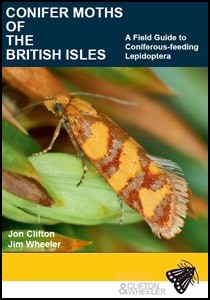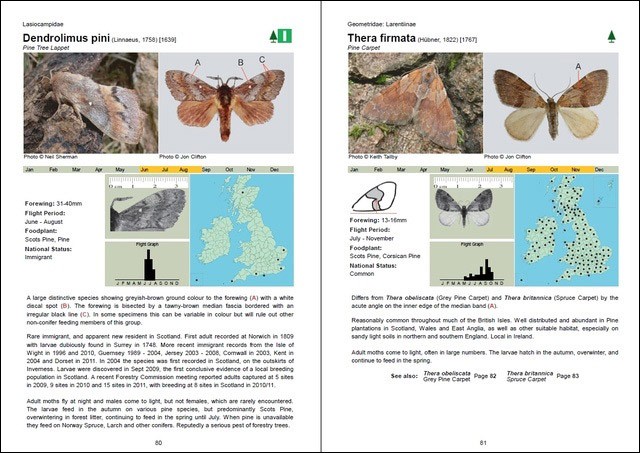Conifer Moths of The British Isles by Jon Clifton and Jim Wheeler

A short yet useful introduction describes the contents of the main species texts, and highlights several general allowances that must be made when one compares photo quality and colour interpretation in images of live and specimen moths. It stresses the need for a hand lens when observing captive and set moths, as well as suggesting that some difficult species may need to be examined to dissection level for definitive identification! Furthermore, it also categorises the two main food plant families and illustrates, with technical terms, the basic anatomy of a typical moth (showing the important morphological characteristics) using a mounted specimen — hugely helpful for comparing one species to another.
The main section of the book contains single species accounts that cover not only the 108 conifer moths, but also a further four micros and ten macros that are potential visual confusion species. Each page is headed with the scientific name alongside the appropriate British checklist number and the English name.
Each species is illustrated with two images: one showing a typical resting pose of a live adult, and the other a mounted specimen. An actual size and shape illustration of both a lateral resting moth and set specimen in millimetres is very useful (especially for the micros), as is the concise text, which describes salient identification features that often cross-reference annotated pointers from the specimen image. The texts also cover general distribution in relation to food plant and habitat and when the adult moths are most likely to be encountered, reflected in the simple graphs that show flight periods in half-monthly abundance peaks. A distribution map shows the vice-counties in which the species has been recorded in Britain and Ireland.

Sample double page (pp80–81) from the main species accounts section.
For some species, there are details for likely places to find feeding larvae as well as tips for locating them in the field. The entire section boasts 211 colour images, including a few that show feeding signs of the larvae. In addition, there are six species comparison plates that show enlarged examples of difficult species pairs, trios and groups (some including both sexes) with additional notes. Almost all of the images of live moths are of excellent standard, and are against natural backgrounds. The front cover subject — Aethes rutilana — is so well captured that it makes you want to head for northwest Scotland as soon as it emerges in July! However, some of the Argyresthia and Gelechid specimens are (by the species' own nature!) a bit dull. The species selection includes 42 tortrix moths, which compliments those dealt with in the authors' previous title. This includes two new species, both recorded for the first time in Britain in 2011, which have not previously been described in any British literature. In addition, the rather attractive Fir Carpet — a macro new to Great Britain during the now famous migrant influx in October 2011 — is also included.
Following the main section are 104 thumbnail images, complete with clear references given to the page number on which the species' main text can be found: this could be quite useful in a dark wood at midnight armed only with a torch! These are followed by an additional list of 20 polyphagous moth species (whose larvae are known to feed on both conifers and other species), and a full list of all common and scientific names of all the conifer plants mentioned in the texts. The book concludes with references, useful websites and moth species indexes — all helpful additions for the expert and novice alike.
Thanks to its unique visual method, this compact publication deals with over 122 species in a very manageable way: it is very clear that the authors' interest in conifer-dwelling moths is paramount to making it such a useful buy. Aimed at all levels of moth-ers, it is equally relevant to those who prefer to catch moths in their own gardens (where Leylandii hedging, cultivated junipers and other ornamental firs are found), right through to the more adventurous among us who may explore natural conifer-based forest, heathland and moorland habitats in more exotic climes. Its appeal is furthered by the price: at £20 (plus p&p), it is a steal when compared to many of the weightier, expensive and often out-of-print British and European handbooks that deal with many of the species.
Published independently by Clifton and Wheeler 2012.
ISBN 978-0-9568352-1-5
Available from Anglian Lepidopterist Supplies


